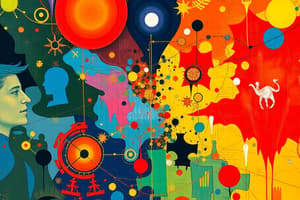Podcast
Questions and Answers
Which of the following topics is NOT considered a part of microeconomics?
Which of the following topics is NOT considered a part of microeconomics?
- The influence of the government’s budget deficit on economic growth. (correct)
- The role of Microsoft’s market power in the pricing of software.
- The effectiveness of antipoverty programs in reducing homelessness.
- The impact of cigarette taxes on the smoking behavior of teenagers.
Which statement is an example of a positive statement?
Which statement is an example of a positive statement?
- Congress ought to pass the new healthcare law.
- The president should support renewable energy initiatives.
- The government should enact policies to reduce homelessness.
- If the minimum wage is increased, unemployment will rise. (correct)
Which part of the government does NOT typically rely on the advice of economists?
Which part of the government does NOT typically rely on the advice of economists?
- Office of Management and Budget.
- Department of Justice.
- Department of Education. (correct)
- Department of the Treasury.
Economists may disagree due to differences in which of the following?
Economists may disagree due to differences in which of the following?
Most economists view tariffs as:
Most economists view tariffs as:
Which of the following is a reason for economists' disagreement?
Which of the following is a reason for economists' disagreement?
Which scenario illustrates a normative statement?
Which scenario illustrates a normative statement?
What is the primary reason economists provide advice to policymakers?
What is the primary reason economists provide advice to policymakers?
What is the primary purpose of assumptions in economic models?
What is the primary purpose of assumptions in economic models?
Which of the following correctly describes the Circular-Flow Diagram?
Which of the following correctly describes the Circular-Flow Diagram?
What does the Production Possibilities Frontier (PPF) illustrate regarding opportunity costs?
What does the Production Possibilities Frontier (PPF) illustrate regarding opportunity costs?
How are microeconomics and macroeconomics distinguished in economic studies?
How are microeconomics and macroeconomics distinguished in economic studies?
In the context of economic models, which statement about their representation is accurate?
In the context of economic models, which statement about their representation is accurate?
What characterizes a point located inside the Production Possibilities Frontier (PPF)?
What characterizes a point located inside the Production Possibilities Frontier (PPF)?
Which of the following statements most accurately depicts the role of economic theories?
Which of the following statements most accurately depicts the role of economic theories?
Which economic model demonstrates interactions within the economy effectively?
Which economic model demonstrates interactions within the economy effectively?
Flashcards are hidden until you start studying
Study Notes
The Scientific Method in Economics
- Economists utilize the scientific method to analyze real-world phenomena.
- They develop theories and test them with data.
- Assumptions simplify complex situations to better understand cause and effect.
The Role of Assumptions
- Economists make assumptions to simplify models and make them easier to comprehend.
- An example is the simplified model of international trade with only two countries.
Economic Models
- Economic models are simplified representations used to analyze economic situations.
- The Circular-Flow Diagram and Production Possibilities Frontier are two key models.
Circular-Flow Diagram
- Illustrates the flow of goods, services, and resources between households and firms.
- Shows the interactions in two main markets: the market for goods and services, and the market for factors of production.
Production Possibilities Frontier (PPF)
- Shows the trade-offs between producing two goods.
- Demonstrates opportunity costs, efficiency, and economic growth.
Microeconomics vs Macroeconomics
- Microeconomics focuses on individual markets and decision-makers like households and firms.
- Macroeconomics focuses on broader economic factors such as inflation, unemployment, and national income.
Positive vs Normative Analysis
- Positive statements are objective and based on facts.
- Normative statements are subjective and value-based.
- Example:
- Positive: Increasing the minimum wage will reduce employment.
- Normative: The government should raise the minimum wage.
Economists as Policy Advisers
- Economists provide advice to policymakers based on positive analysis.
- They offer recommendations on issues like minimum wage laws, taxation, and healthcare reforms.
Why Economists Disagree
- Differences arise from varying scientific judgments, models, and values.
- For example, economists may disagree about the balance between fairness and efficiency.
Studying That Suits You
Use AI to generate personalized quizzes and flashcards to suit your learning preferences.




